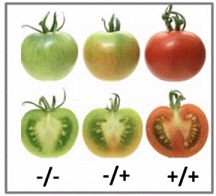Tomato ACC2 Take-Home Assignment
Background Information:
The tomato plant (Solanum lycopersicum) is one of the most popular vegetable crops in the world and its fruit is highly consumed by society. The ripening of tomatoes is an important developmental stage which involves the production of the bright red carotene lycopene, loss of chlorophyll, fruit softening and an increase in aroma (Fig. 1A). The plant gaseous hormone ethylene (C2H4) is produced by the cells of an unripen tomato fruit which triggers the ripening process. Biosynthesis of ethylene occurs through a biochemical pathway involving methionine
(Met), S-adenosylmethionine (AdoMet) and 1-aminocyclopropane-1-carboxylic acid (ACC) (Fig. 1B). The tomato gene ACC2 encodes an ACC synthase that catalyzes the conversion of AdoMet into ACC, the precursor of ethylene (Fig. 1B). During fruit ripening. the ACC2 gene is expressed and ethylene is produced. Loss of ACC2 gene function results in reduced ethylene roduction and delayed fruit ripening.

There are two alleles of the tomato ACC2 gene. One allele (referred as “+” or wild type) produces ACC2 protein which results in the synthesis of ACC and ethylene hormone in the tomato fruit. In contrast, the other allele (referred as “-“) does not produce any ACC2 mRNA (and hence no ACC2 protein) resulting in an inability to produce ACC and ethylene.
Questions:
01. According to the central dogma of molecular biology, explain how alleles cause phenotypic variation. Your answer should also include the definition of alleles.
Q2. The figure on the below shows the phenotypes of the three tomato ACC2 genotypes (+/+, +/- and -/-). Given the previous information describing the two types of alleles of the ACC2 gene, explain how these three genotypes produce the distinct phenotypes. Your answer should also indicate how the relative levels of ACC2 protein in each genotype contribute to its phenotype.

Transcript map of Precursor mRNA (Pre-mRNA) encoded by the tomato ACC2 gene (mustard yellow rectangles indicate the coding regions of the pre-mRNA)

Q3. Refer to the transcript map of the tomato ACC2 precursor mRNA above:
(a) How many introns in the ACC2 transcript?
(b) How many exons in the ACC2 transcript?
(c) What are the blue rectangles at both ends of the transcript?
(d) Which direction does transcription occur (L to R or R to L)?
Q4. Hand-draw the transcript map of the tomato ACC2 precursor mRNA from the figure above and indicate the location of the transcriptional start site, transcriptional stop site, start codon, stop codon and ORF on your figure.
Q5. A new allele of the ACC2 gene (ACC2-D) has been isolated that causes tomatoes to ripen prematurely. Comparison of the DNA sequence between the ACC2-D allele and the wild-type (+) allele reveals a nucleotide change in the promoter. Provide an explanation how the location of a nucleotide change in the ACC2-D allele causes premature ripening of the tomato.
Q6 Harvesting ripe tomatoes is problematic as farms can be far away from grocery stores and bruising and spoilage can take place during transportation. Therefore, green tomatoes are harvested and reach produce distributors or grocery stores as unripen tomatoes. However, tomatoes at the grocery store always appear perfectly ripe. How do produce distributors/grocery stores accelerate the ripening of green tomatoes to be ready for sale?
Q7 Hand-draw a simple diagram of meiosis in a tomato germ cell heterozygous for the ACC2 gene. Your diagrams should clearly indicate the behaviour of the chromosomes/chromatids carrying the alleles (“+” and “) of the ACC2 gene in meiosis I and meiosis II. Include G1, G2, prophase 12, metaphase 12, anaphase 12, telophase 12, prophase 2. metaphase 2, anaphase 2 and telophase 2). Also show crossing over in prophase 1.





